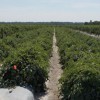Abstract
Alternatives to the traditional production system that reduce production cost would be economically beneficial to the Florida tomato industry. Compact growth habit tomatoes are determinate varieties with a unique architecture that may provide the basis for a viable alternative production system for Florida. These tomatoes have low growth and spreading characteristics, forming compact plants that hold fruit above the ground on short branches. They do not require staking, tying, or pruning, so they may be used by the Florida mature-green fresh-market tomato growers to reduce labor costs. This 5-page fact sheet was written by Monica Ozores-Hampton, Aline Coelho Frasca, John Scott, and Samuel Hutton, and published by the UF Department of Horticultural Sciences, September 2013.
References
Adelana, B.O. 1980. Relationship between lodging, morphological characters and yield of tomato cultivars. Scientia Hort. 13:143-148. https://doi.org/10.1016/0304-4238(80)90078-3
Bai, Y. and P. Lindhout. 2007. Domestication and breeding of tomatoes: what have we gained and what can we gain in the future? Ann. Bot. 100:1085-1094. https://doi.org/10.1093/aob/mcm150
Barton, D.W., L. Butler, J.A. Jenkins, C.M. Rick, and P.A. Young. 1955. Rules for nomenclature in tomato genetics (including a list of known genes). J. Hered. 46:22-26. https://doi.org/10.1093/oxfordjournals.jhered.a106504
Campbell, C.G. and I.L. Nonnecke. 1974. Inheritance of an enhanced branching character in tomato (Lycopersicon esculentum Mill.). J. Amer. Soc. Hort. Sci. 99:358-360.
Clayburg, C.D., L. Butler, E.A. Kerr, C.M. Rick, and R.W. Robinson. 1966. Third list of known genes in tomato (with revised linkage map and additional rules). J. Hered. 57:188-196. https://doi.org/10.1093/oxfordjournals.jhered.a107504
Clayburg, C.D., L. Butler, E.A. Kerr, C.M. Rick, and R.W. Robinson. 1979. Report of gene list committee. Tomato Genet. Coop. 29:2-17.
Davis, J.M. and E.A. Estes. 1993. Spacing and pruning affect growth, yield, and economic returns of staked fresh-market tomatoes. J. Amer. Soc. Hort. Sci. 118:719-725. https://doi.org/10.21273/JASHS.118.6.719
Hartz, T., G. Miyao, J. Mickler, M. Le Strange, S. Stoddard, J. Nunez, and B. Aegerter. 2008. Processing tomato production in California. Univ. California, Veg. Res. and Info. Ctr. Pub. 7228. 14 Aug. 2013. http://www.anrcatalog.ucdavis.edu/pdf/7228.pdf https://doi.org/10.3733/ucanr.7228
Kemble, J.M., J.M. Davis, R.G. Gardner, and D.C. Sanders. 1994. Spacing, root cell volume, and age affect production and economics of compact-growth-habit tomatoes. HortScience 29:1460-1464. https://doi.org/10.21273/HORTSCI.29.12.1460
Le Strange, M., W.L. Schrader, and T.K. Hartz. 2000. Fresh-market tomato production in California. Univ. California, Veg. Res. and Info. Ctr14 Aug. 2013. http://anrcatalog.ucdavis.edu/pdf/8017.pdf https://doi.org/10.3733/ucanr.8017
McAvoy, E. and M. Ozores-Hampton. 2011. Unique challenges for Florida growers in tomato and pepper production. Univ. Florida, IFAS, EDIS Circ. IPM-201. 14 Aug. 2013. http://edis.ifas.ufl.edu/in733
Ozminkowski, Jr., R.H., R.G. Gardner, R.H. Moll, and W.R. Henderson. 1990a. Inheritance of prostrate growth habit in tomato. J. Amer. Soc. Hort. Sci. 115:674-677. https://doi.org/10.21273/JASHS.115.4.674
Ozminkowski, Jr., R.H., R.G. Gardner, W.R. Henderson, and R.H. Moll. 1990b. Prostrate growth habit enhances fresh-market tomato fruit yield and quality. HortScience 25:914-915. https://doi.org/10.21273/HORTSCI.25.8.914
Ozores-Hampton, M., E. McAvoy, S.M. Olson, K. Cushman, and N. Roe. 2011. Tomato varieties for Florida - Florida "red rounds", plum, cherries, and grapes. Univ. Florida, IFAS, EDIS Circ. HS1189. 14 Aug. 2013. http://edis.ifas.ufl.edu/hs1189
Peralta, I.E. and D.M. Spooner. 2007. History, origin and early cultivation of tomato (solanaceae), p. 1-27. In: M.K. Razdan and A.K. Mattoo (eds.). Genetic improvement of Solanaceous crops. Sci. Publishers, Enfield, NH. https://doi.org/10.1201/b10744-2
Scott, J.W., S.F. Hutton, and J. Strobel. 2010. Some highlights from the University of Florida tomato breeding program. Proc. Florida Tomato Inst. 53:9-10.
Stubbe, H. 1959. Mutanten de kulturtomate Lycopersicon esculentum Mill. III. Kulturpflanze 7:82-112. https://doi.org/10.1007/BF02099382
Stubbe, H. 1960. Mutanten der wildtomate Lycopersicon pimpinellifolium (Jusl.). Mill. II. Kulturpflanze 8:110-137. https://doi.org/10.1007/BF02096008
U.S. Department of Agriculture. 1997. United States standards for grades of fresh tomatoes. 14 Aug. 2013. http://www.ams.usda.gov/getfile?dDocName=STELPRDC5050331
U.S. Department of Agriculture. 2010. Vegetables 2009 summary. 14 Aug. 2013. http://usda01.library.cornell.edu/usda/nass/VegeSumm//2010s/2010/Vege-Summ-01-27-2010.pdf
U.S. Department of Agriculture. 2013. Vegetables 2012 summary. 14 Aug. 2013. http://usda01.library.cornell.edu/usda/current/VegeSumm/VegeSumm-01-29-2013.pdf
VanSickle, J., S. Smith, and E. McAvoy. 2009. Production budget for tomatoes in southwest Florida. Univ. Florida, IFAS, EDIS Circ. FE818. 14 Aug. 2013. http://edis.ifas.ufl.edu/fe818 https://doi.org/10.32473/edis-fe818-2009
Zahara, M.B. and R.W. Scheuerman. 1988. Hand-harvesting jointless vs. jointed-stem tomatoes: jointless-stem fresh-market varieties take much less time to pick than jointed types. Univ. California, Veg. Res. and Info. Ctr 14 Aug. 2013. http://ucce.ucdavis.edu/files/repositoryfiles/ca4203p14-68779.pdf

